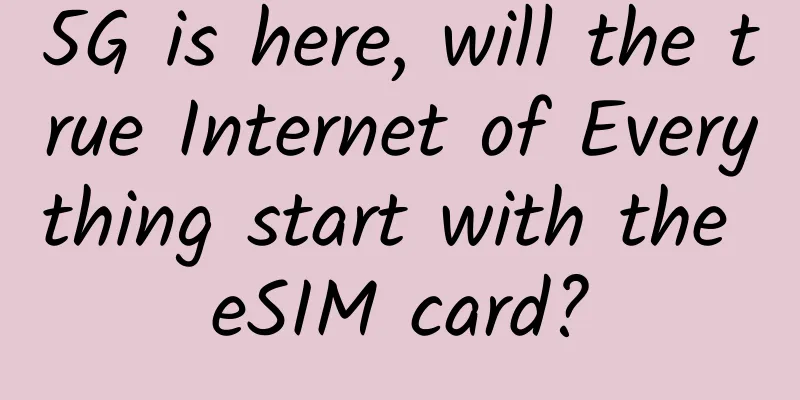5G is here, will the true Internet of Everything start with the eSIM card?

|
After experiencing SIM card cutting, microSIM card, and nanoSIM card, have you ever thought that one day your mobile phone will no longer need these physical cards? On March 29, 2019, China Unicom held a joint first-sale cooperation launch conference with the theme of "Unicom eSIM, no card, more freedom". At the conference, China Unicom announced that it would expand the eSIM wearable device independent number service from the pilot to the whole country, and announced the first batch of eSIM product cooperation brands. The era of eSIM replacing SIM card is coming. Simply put, eSIM is the electronic version of traditional SIM card. Ordinary SIM card has a physical chip, while eSIM card is embedded in electronic devices and is just a data file for users. This means that No.1 will be able to support multiple terminals at the same time, and the device can dial and surf the Internet without inserting a card. Smart devices are iterating to promote SIM card upgrades, and the 5G IoT trend is irreversible In 2007, Steve Jobs held the 3.5-inch first-generation iPhone and redefined the mobile phone at the press conference. This device removed the mobile phone keyboard and replaced it with a home button. The 11.6mm thick device smoothly combined mobile phone communication, audio and video playback, and web browsing. The birth of the first generation of Apple changed many trends. For example, the 3.5-inch screen may seem small, but at the time, it was larger than most mobile phone screens. The display size of the Nokia N95 smartphone at the time was only 2.6 inches. Today, the average smartphone screen is 6 inches. iPhone thickness changes Apple has continuously applied emerging technologies to new products. The iPhone 3G was officially released on July 11, 2008. This phone began to support 3G networks and mobile data transmission was faster. In 2008, Apple's iPhone sales reached 17 million units, and in the following years, iPhone sales maintained a steady growth. The iteration of smart devices is one of the biggest drivers of SIM card upgrades. As Apple's devices become thinner and lighter and its relationship with telecom operators becomes closer, Apple applied for a patent for a virtual SIM card in 2011 and tried this concept on the iPad Air 2. Then in 2017, it was promoted again on the smaller smart wearable device Apple Watch 3. Although eSIM technology has been around for many years, Apple's promotion has not made this technology a household name. In 2017, among the three major telecommunications companies in China, only China Unicom and accounts in Shanghai, Guangdong, Henan, Hunan, Hubei, and Tianjin provided support for Apple Watch 3. To some extent, there is a game between smart devices and telecommunications manufacturers using eSIM technology, so global promotion is more difficult. eSIM cards are easy to change, can save space for device upgrades, and truly realize the independent use of smart devices, which plays a vital role in the practical leap of the Internet of Things industry. However, the use of eSIM cards in the IoT field may not be able to highlight its effectiveness. For example, many products are not perfect due to data transmission problems. Routers will malfunction due to insufficient computing power or insufficient bandwidth for multiple cameras to write data at the same time, and smart devices will be useless when connected to the Internet. The emergence of 5G can greatly enhance the basic capabilities of IoT. As the Internet dividend gradually reaches its peak, the Internet of Things is moving from concept to real consumption, and various technology companies are competing to make diversified strategic layouts. As the core technology for realizing the layout of the Internet of Things, 5G applications have created opportunities for the peak of the intelligent ecology of the Internet of Things market. 5G provides high connection numbers and high network speeds, and eSIM cards help smart devices to be used independently from mobile phones and other devices. Perhaps this is the beginning of the Internet of Everything. eSIM bundling companies and operators, JD.com and China Unicom, but just a small step Internationally, mainstream operators such as AT&T, Verizon, NTT Docomo, CK, Orange, etc. have already launched eSIM services. In China, the application of eSIM cards is inseparable from the permission unlocking of communication companies. eSIM cards need to be embedded, which means that the partnership between operators and the Internet of Things, artificial intelligence, big data and other fields will be closer. Among the three major operators, China Unicom has been the most active in the field of eSIM cards. Previously, the eSIM independent number service not only supports Apple products, but also supports Huawei sports watches, and it is reported that the number of users has reached 200,000. In the second quarter, China Unicom actively cooperated with industry partners. On the morning of April 23, it successfully held the "2019 Shanghai 5G Innovation and Development Summit and China Unicom Global Industry Chain Partner Conference" and began to jointly explore new models of ecological cooperation. Many players in the smart wearable field see cooperation with operating companies as a good opportunity for development. For example, Jingxuan, a private brand under JD.com, was shortlisted by China Unicom and became the first eSIM hardware brand to cooperate with China Unicom. In fact, Jingxuan is not well-known in this field, and its cooperation with China Unicom aims to transform from a channel business to a brand business in the field of the Internet of Things. There are also vertical brands such as "Chumowenwen" that attach great importance to cooperation with China Unicom. eSIM is seen by major manufacturers and platforms as an opportunity to overtake others. However, cooperation between JD.com and China Unicom is just a drop in the ocean for building a relatively mature open IoT ecosystem. Whether IoT product brands can have a sufficient market share depends not only on network partners, but also on several key competitive factors. 1. Whether it can withstand the hardware test The cellular version of Apple Watch 3, which is more mature in technology, has built-in GPS and has realized independent calling, message reply, storage, song playing and other functions, which can meet the basic outdoor use of smart watch users. However, Apple officially announced that the battery life of Apple Watch 3 is 18 hours. When connected to an iPhone, it can have 3 hours of talk time, and only "more than 1 hour" when connected to the network. In addition, the outdoor sports battery life is reduced to 5 hours in GPS state, and if the network is turned on at the same time, the battery life is only 4 hours. It is actually difficult to go out with only a smart device without relying on a mobile phone. Apple's largest parts supplier can only do this, not to mention other brands. The emergence of eSIM has provided soil for smart devices to incubate more functions. Without these functions, the hardware seems not smart enough, but with these functions, the hardware cannot support them. This contradiction makes many people stay away from such products. 2. Can it address pain points and become a rigid demand of users? Currently, QQ Music already supports online use on Apple Watch, and the effect is close to native music, which improves the usability of smart devices, but the pessimistic power consumption makes these functions useless. The emergence of eSIM function means that smart devices are becoming more and more functional and can complete most basic tasks. Wearing only a smart watch for exercise can achieve the best exercise effect, but the premise is that there is no better way to wear a mobile phone when going out, and now there are many sports peripherals that assist wearing a mobile phone. In most scenarios at this stage, IoT products cannot be separated from mobile phones for a long time. Brands without mobile phone products have basically no hope of building their own ecosystem, and it is extremely difficult to increase market share. On the contrary, there is a rigid demand in the market for children and the elderly, who have a strong demand for safe positioning and independent calls. Children may not be able to use mobile phones, and the elderly often forget to bring their mobile phones when going out. Starting from these pain points, rather than blindly competing in functions, may be more important for vertical brands in this field. The slow progress of the promotion and benefit coordination period is a good opportunity for future extensive application layout The eSIM report released by GSMA this year predicts that 20% to 35% of smartphones in China will be connected via eSIM by 2025. In 2025, China will also become the world's largest eSIM smartphone market, accounting for about one-fifth of global eSIM smartphone connections. However, the development of domestic eSIM business is not fast. In October 2018, China Telecom began to launch eSIM pilot projects in Shanghai, Guangzhou, Chengdu and Nanjing. So far, only Wuhan and Shenzhen have been added. On January 23 this year, China Mobile started the trial operation of the eSIM one-number dual-terminal service. It can bind mobile phones and wearable devices and share the same number, call charges and traffic packages. From January 23 to December 2019 is the service trial phase, and the first batch only supports seven cities including Tianjin, Shanghai, Nanjing, Hangzhou, Guangzhou, Shenzhen and Chengdu. China Unicom, which was the first to deploy eSIM business, received the approval of the Ministry of Industry and Information Technology in March this year, officially announcing that the eSIM wearable device independent number business will be expanded from the pilot to the whole country. At present, eSIM services are only available in a few cities on a trial basis, and are still not the mainstream consumer market. They are still in the promotion and interest coordination period, and progress is relatively slow. However, it is foreseeable that as a technology that will be widely used in the future, eSIM devices and applications will become an important direction of technological development, and more and more devices will support eSIM in the future, and the trend is unstoppable. 1. Extend the physical properties of devices to meet future innovation needs Although the size of SIM cards is relatively small now, as mobile devices become thinner and lighter, and smart wearable devices are applicable in more and more scenarios, SIM cards can no longer meet future demand trends. eSIM cards have advantages that ordinary cards do not have. Not only do they not take up space in electronic devices, but they also do not require side openings and can improve the three-proof level of the device. Because there is no physical card slot, eSIM is also the best choice for flexible and foldable mobile phones. There is more room for imagination in the future form of mobile phones or other electronic devices. Early deployment of this function is beneficial to the future development of such products. 2. Cardless system reduces equipment costs and provides two-way convenience for operation and consumption eSIM does not require the replacement of physical cards, which can also save a lot of money for operators. If eSIM users want to change operators or handle other services, they no longer need to go to the business hall to handle it. They can apply online with just a few clicks. At present, although the eSIM function has not yet been popularized and is still in the stage of cultivating user habits, only products that are competitive enough will have the opportunity to guide users. However, once this two-way convenience becomes a trend, it may be a way to open up the situation for some products that are at a competitive disadvantage but have close cooperation with operators and can be bundled with preferential tariffs. 3. Opportunities for companies in the fields of big data, Internet of Things, and artificial intelligence The eSIM function is a new starting point and opportunity for many companies. For operators, they have the opportunity to become a connection point, connecting partners and users, becoming a data intelligence technology service provider, and building their own industrial ecosystem. For companies in the big data field, they have the opportunity to obtain richer mobile data. Companies in the fields of the Internet of Things and artificial intelligence also have more practical scenarios. For example, smart watches can play music online, which means they will have the opportunity to connect with more things in the future. In addition, eSIM also makes the entrance to the Internet of Things more possible, such as using it in smart headphones, and adding voice interaction will completely free people's hands. The advent of the 5G era has brought development opportunities to many fields, and the eSIM function will unleash its once limited power in the 5G environment. We cannot deny that the eSIM function will still bring many challenges to smart devices at present, but in the future, eSIM can help these devices to maximize their imagination in terms of form and function. eSIM may also help products in the field of the Internet of Things break the conclusion that mobile phones are the only entrance to the IoT. Therefore, before the function is fully popularized, it is the gateway for companies in related fields to make early arrangements. |
<<: A complete analysis of the IoT strategies of Huawei, Alibaba and China Unicom
Recommend
How does SpringBoot ensure interface security? This is how veterans do it!
Hello everyone, I am Piaomiao. For the Internet, ...
RackNerd Mid-Autumn Festival Promotion, Los Angeles KVM Annual Payment Starting from $9.89
The Mid-Autumn Festival is still early, but the p...
Which open source API gateway is better?
[[412862]] Image from Baotu.com Today I will disc...
Mellanox Launches Innovative ConnectX-6 Dx Chip, BlueField-2 Secure Cloud SmartNIC and I/O Processing Unit Solutions
Beijing, China – September 3, 2019 – Mellanox Tec...
The price of 4G mobile chips will rise instead of fall in the second half of 2021
As mobile chip suppliers focus more on 5G solutio...
Game lag? Be careful to use the wrong WiFi frequency at home
When you use WiFi at home to play games, you alwa...
Practical VPC Network Planning on the Cloud
What is VPC Virtual Private Cloud (VPC) is a priv...
Kurun: $59/year-2GB/40GB/1TB@500M/China Telecom CN2 GIA/China Unicom CUII9929/China Mobile CMIN2
Kurun is a domestic merchant founded in 2019. Its...
Empowering the ecosystem and working together! Borei Data becomes a member of the Photosynthetic Organization
As the domestically-developed industry ecosystem ...
Gateway programming: How to reduce R&D costs through user gateways and caches?
If the user's traffic is like the surging wav...
7 key features of 5G mobile phones
1. Support high-power terminals Compared with bas...
Intent-driven networking is reshaping network service delivery
When configuring a network, engineers typically f...
5G is coming, will you still port your number to another network?
According to the unified deployment of the Minist...
Karamay: Huawei's first cloud strategic cooperation city in the world
Karamay is a desert city that was born and prospe...
Huawei Cloud launches full-stack private cloud solution to support enterprise cloud transformation
[51CTO.com original article] Recently, the Huawei...









